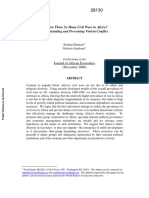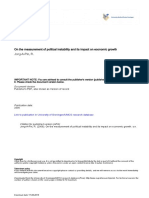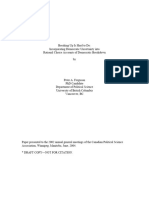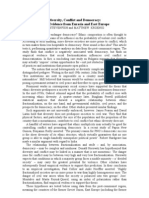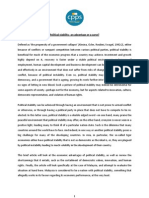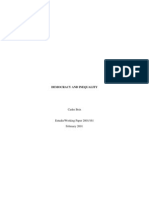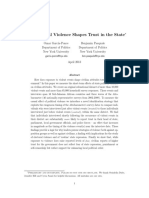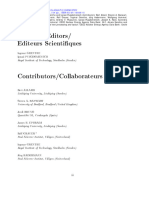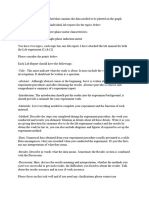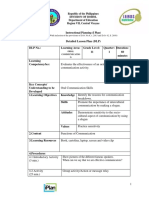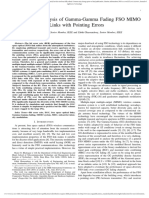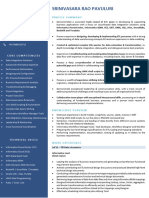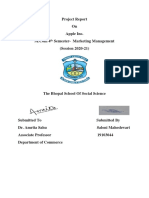Quantitative Data Analysis and
Interpretation
Approved Essay Title: Explaining Political Instability in a
Quantitative Cross-National Study (QDA)
2007-2008
Word Count: 5202
Page 1 of 29
�Abstract:
This essay reports statistical correlations and associations between key variables and
political instability. The variables selected represent internal and external, as well as
economic and political, factors which allows conclusions to be drawn as to their
relative importance for the explanation of political instability. This is done through
statistical techniques such as regression analysis. This essay finds that economic
factors and internal factors seem to have the most relevance for the analysis of the
correlates of political instability. The essay concludes by highlighting possible issues
with the analysis including the measurement of variables and cause and effect.
Part 1 – Introduction
The central research question of this essay is concerned with the question of
why political instability happens, placing the analysis in a cross-national context. The
issue of political instability is important because of the problems, both social and
economic, which political instability brings to the people of a country which is being
deeply affected by it. Indeed, as Shaw notes, “Prospects for regional development
recede as conflicts both escalate and proliferate” (2003, p. 489). An understanding of
political instability could lead to developments of policy strategies aimed at
preventing these problems when it arises, and aimed at preventing its occurrence.
Without an accurate theoretical understanding of why and how instability is generated
even the best meaning action may fail. The issue of political instability is also
theoretically interesting because of the numerous and disparate variables which have
been suggested as explanatory in this field. Just some of the explanations offered for
political instability include; economic inequality (Lichbach 1989, passim), poor
Page 2 of 29
�regional relations (Brown, 2001, p. 16), the impact of crime (Brown, 2001, p. 18) and
ethnic fractionalisation (Gurr, 1993, p.161). More research is obviously needed in this
area in order to determine what the relationship actually is and which factors are more
important. In this essay the relative importance of political and economic factors will
be assessed as well as the relative importance of internal and external factors,
concluding that economic and internal factors seem most important respectively.
The dependent variable of this study is the level of political instability 1. The
independent variables are; wealth, level of democracy, ethnic fractionalisation and the
number of border states with any kind of major conflict.
I – Research expectations:
Wealth and political instability
We may expect, before analysis, a negative relationship between the wealth of
the people of a country and political instability. Theoretically there are at least some
reasons to suppose that this is the case, mostly relating to what might be termed the
opportunity costs of violence. Przeworski and Limongi used income per capita to
show that democratic regimes were most vulnerable to collapse when the level of
income was low absolutely (1997, p. 161). Taking this as a starting point, the
relationship between the overthrowing of democracy and political instability seems
intuitively obvious; when democracies are overthrown violence and repression often
follows. This gives us a theoretical reason for assuming that wealth and political
instability as defined above are related for the same reasons that income per capita
1
The definition of political instability which is used here will follow Kaufman in his definition of the
term “political stability”, although will obviously focus on the negative side. A full explanation of this
term can be found in World Bank (2007) and the Univariate analysis section in this work.
Page 3 of 29
�and democratic death are related. Here no assumption is made as to the source of the
violence, whether it is initiated from above, by elites, or below, by mass level forces.
This theory, though, only explains why violence becomes an option which can be
taken; the reason why violence is chosen still needs to be explained. Przeworski and
Limongi suggest that the choice is likely to be made by those who seek to enlarge
their own share of the income distribution whilst the marginal costs are lowered, and
thus so is the risk (1997, p. 166). This is largely in line with Shaw’s observations of
conflicts within Africa; increasing conflicts over diminishing resources to acquire (see
Shaw, 2003, p. 488). Similarly, Gurr noted that objective conditions like poverty were
crucial grievances used by elites to mobilise people for rebellion (1993, p. 189).
Whether the effect which Przeworski and Limongi noted still applies strongly is an
open question, Bermeo argued that wealth is “not a necessary condition of democratic
durability” and as such we may question if wealth still has explanatory force in terms
of political instability (2003, p. 169).
Level of democracy and political instability
It has been observed that when a country becomes a “full” democracy civil
wars are an extremely rare, if not completely absent, phenomena (see Hegre et al,
2001, pp. 33-34). This might be because, as Bermeo claimed, that people are more
likely to engage in violent competition, rather than peaceful and democratic
competition, when the costs of the former are reduced compared to the latter (2003, p.
164). Semi-democracies have been regarded as bringing stabilising characteristics to
countries and it has been contended that they can even prevent conflict in societies by
allowing demands for at least some popular consultation whilst at the same time
Page 4 of 29
�allowing the present ruling elites to maintain power which they would be unwilling to
give up (see Case, 1996, p. 457). Despite this we should not necessarily expect the
relationship to be a simple linear one. It has also been seen that countries which are
harshly authoritarian have fewer civil wars than those which are in the intermediate
stages of democratisation (Hegre et al, 2001, p. 33). These analyses are also likely to
hold true for other forms of violence which fall short of civil war, including ethnic
violence (see Snyder, 2000, p. 310). This in itself is surprising if Bermeo was correct.
One explanation sees potential conflicts between ethnic groups, or between different
communities, as having already existed but laying “dormant” because of the
repressive nature of authoritarian regimes (Byman and Van Evera, 1998, p. 33).
Another explanation sees national elites who do not wish to abandon their own
political power creating conflict and nationalism to allow them to keep their power
(Snyder, 2000, p. 36). Indeed, there seems to be considerable amounts of qualitative
data to back this claim (see Mansfield and Snyder, 2005, pp. 169-227). The exact
expectation is then unclear and will alter depending on whether we accept Case’s
analysis or that of Mansfield and Snyder.
Near-by conflicts and political instability
It is important to note that political instability, as defined by Kaufman, can
often be caused by forces external to the country in which the problems are manifest.
External factors operating at the mass-level include “spill-over” or “diffusion” of
conflict from other states (Brown, 2001, p. 16). These factors can operate regardless
of domestic problems, or absence thereof. To focus exclusively on internal factors,
then, will lead to an incomplete analysis and may even create misleading results.
Page 5 of 29
�Spill-over of conflict could be created either by “swarms of refugees” or key radicals
moving operations due to conflict (see Brown, 2001, p. 16). Foreign armies can also
play a key role in causing political instability including, but not limited to, leading
direct military assaults on the government (Shaw, 2003, p. 491). Similarly “diffusion
and contagion” of conflicts has been shown in previous research to be a factor in
explaining conflict, although not a particularly strong one in all cases (Gurr, 1993, p.
189). Theoretically, then we should expect to see a relationship between the proximity
of foreign conflicts or foreign hostile regimes and the amount of political instability
which is found within a country.
Ethnic fractionalisation and political instability.
The degree to which a country is ethnically homogenous has been suggested
as a possible explanatory factor in many aspects of political instability. Ted Gurr
notes that most countries have seen conflicts relating to the “terms of incorporation
for ethnic minorities…” (1993, p. 161). Whilst, as Gurr notes, this does not have to be
violent conflict we at least have some reason for expecting to see more conflict in
countries which have a higher degree of ethnic heterogeneity (see Gurr, 1993, p. 161).
This theory runs counter to Collier and Hoeffler who argue that fractionalisation will
increase the costs of recruiting to a rebel force and will therefore reduce instances of
civil war, and so political instability (2000, p. 8).
Page 6 of 29
�The Null Hypothesis
As always the null hypothesis is a statement of no difference and can be formulated
as;
- There is no difference in terms of political instability between countries with
differing: levels of wealth, levels of ethnic fractionalisation, number of geographically
close states with major conflicts, or levels of democracy.
This then means that the hypothesis can be formulated as stating that there is a
difference between the levels of political instability in countries, and those countries’:
levels of wealth, levels of ethnic fractionalisation, number of geographically close
states with major conflicts, or levels of democracy. Showing significance in a
relationship between the dependent variable and any one of the independent variables
disproves the null hypothesis relating to that variable and shows that there is a
difference between countries level of political instability which is related to the
independent variable. Importantly significance does not tell us the direction of the
relationship, and this must be discovered by an ex post analysis, which will be
computed if necessary.
The cases are 191 countries from the global indicators data set. These
countries represent a population within the field of study. Whilst this means that they
are technically not a sample it will still be useful to treat them as a sample of the
wider world throughout time. Hopefully this will mean that we can say with greater
confidence that the results found are generalisable into the future as well as having
current time-period empirical validity.
Page 7 of 29
�II – Univariate Analysis
Concept and measurement of political instability
Political instability, the dependent variable, will be measured using Kaufman’s
political stability rating. This means that the relationships which are found
(positive/negative) will actually be the inverse of the relationship we are concerned
with. For example if increasing GDP is found to have a positive relationship with
political stability it has a negative relationship with political instability. The choice for
this variable is because Kaufman’s variable captures the important elements of the
likelihood of politically motivated violence in a way which no other variable is likely
to do. For example, data on the number of politically-motivated deaths in a country
may well accord ‘positive’ scores to countries in which non-fatal political violence is
often used as a measure of coercion. The year which will be selected to measure
political stability will be 1998. Kaufman’s political stability is a largely subjective
measure based on ordinal level assessments from experts and respondents based on
their assessment of the country they are concerned with regarding political violence
(Kaufman et al, 2007, Appendix A). The ordinal sources used to create the political
stability variable are weighted according to the reliability which Kaufman et al.
believes that they have and then aggregated (World Bank, 2007). The variable
measures countries against each other in order to construct a value which can be given
to each, such as that the mean is approaching 0 and the standard deviation is
approaching 1. Because of the way the variable is constructed it is an inherently
imperfect measure of what we are actually trying to measure. Whilst possibilities of
Page 8 of 29
�error are obviously very important here it is important to note that the variable will
still be of use for creating comparisons within the same variable (see Kaufman et al,
2007, p. 15). The variable itself is ostensibly ordinal however because it is continuous
and constructed to be used as an interval-ratio level variable it will be used as such.
A histogram representing the distribution of the countries which are ranked
using the political stability variable is included below (see chart 1 below). As can be
seen data is only available for 163 countries in the world. Missing values are not
explained by the World Bank nor Kaufman, however they are likely to be caused by
lack of available data. It is important to note though that the missing values do not
appear to be just limited to the most authoritarian regimes, or even all of the most
violent ones, as can be seen by the inclusion of North Korea and the Democratic
Republic of Congo respectively.
Chart 1:
Histogram showing distribution of Kaufman's political stability variable
25
20
Frequency
15
10
Mean =-0.0118
Std. Dev. =1.00383
N =163
0
-2.00 0.00 2.00
Kaufman's political stability
Concept and measurement of wealth
Page 9 of 29
� The wealth of the people of a country is a concept which can be measured in
many different ways, income per capita being just one. GDP per capita is another,
related, way of measuring wealth. Per capita income and GDP per capita are likely to
be related in a strong way such as that theoretically one could be operationalized in
place of the other, as Bermeo does (2003, p. 169). If either of these are used the
comparative rankings of countries are likely to be the same. Neither of these are
measures of absolute wealth of countries, this is important because it avoids the issues
relating to extremely large but poor countries having a high GDP compared to
extremely small yet rich countries. Within the global indicators data set there is data
available for GDP per capita for 1997 in 1987 US$. Whilst the year does not perfectly
correspond to the year which is used for the dependent variable it is likely that the
GDP of countries will not have varied significantly over a one year period. This is of
course an untested assumption and could introduce the possibility of error, however in
the absence of perfect data it does not seem like a particularly egregious assumption.
This histogram below (chart 2) displays the variable distribution graphically;
Chart 2:
Page 10 of 29
�A histogram representing distribution of GDP per capita measured in 1987US$ per
country
80
60
Frequency
40
20
Mean =4322.134
Std. Dev. =6940.6476
N =134
0
0.0 5000.0 10000.0 15000.0 20000.0 25000.0 30000.0
GDP per capita in 1997 (measured in 1987US$)
As is immediately apparent the values of this variable are not normally distributed.
This is because of the few countries which have a comparatively high GDP per capita
introducing a positive skew. This is the reason for the extremely high standard
deviation. I will however treat this variable as if it was normally distributed for the
purpose of this essay, although I am aware of the issues this creates. Data is available
for 134 countries. As can be seen from the chart, the standard deviation is
comparatively high.
Concept and measurement of external conflicts
Page 11 of 29
� The types of external conflict which impact upon the functioning of a regime
and create political instability seem likely to be major conflicts within countries which
are geographically close. If this were not the case the “swarms of refugees” problem
may not arise (see Brown, 2001, p. 16). Similarly it is only likely to be major conflicts
which force insurgents or guerrillas to move operations. In both these cases the
countries in which the problems manifest themselves do not have to be directly
involved in the conflict. In the case of foreign powers attacking a country
geographical proximity is less important. Unfortunately no data for the belligerence of
foreign regimes external of geographic proximity is available. This means we are
focussing almost exclusively on what Brown referred to as “bad neighbourhoods”,
that is to say focussing on mass-level external problems (2001, p. 15). The variable
which will be used to measure this concept, then, is the number of border states with
any major conflict during the period 1990-1999 2. The variable will be recoded into a
nominal level dummy variable assessing if a country is in a “bad neighbourhood”; this
is because the available data makes no attempt to judge neither how serious (beyond
an undefined level of “major”) a conflict was nor how long it lasted for. Given this
fact, a country which is bordered by six countries which have had “major” yet short
lived conflicts which caused little trouble internationally will get a higher score than a
country bordered by one country which has had one conflict that destroys much of the
underlying infrastructure of that society. Obviously the latter poses the greater danger
but could be missed if we simply focussed on the numerical results. To avoid
problems like this the variable will be created as having values of “yes” for being in a
bad neighbourhood, which is to say has more than one boarder state with a major
2
It is important to note that this variable would almost certainly include countries which go to war
against each other but are geographically close.
Page 12 of 29
�conflict during the period, or “no”, for not having. The underlying source of this
variable covers years past 1998 when the political instability was measured, but this
may not be a problem. If a major conflict seemed likely to begin within a year it
would not be unexpected to see refugees escaping the probable violence, and so some
effects might be detected then. Similarly problems can take a long time to be resolved
and even a conflict in a bordering state in 1990 might still be having an impact in
1998.
The distributions of this variable after recoding are listed below (Table 1);
Table 1:
Concept and measurement of level of democracy
This concept is represented in the global indicators data set as the variable
“Democracy-Autocracy, mean (1990-99)”. This is measured by subtracting the
commitment to authoritarianism from their commitment to democracy (see CIDCM,
2006). For this variable I shall recode the data into a three category ordinal variable
representing how democratic the country is using categories of “democracies”, “semi-
democracies” and “autocracies”. This variable is a mean throughout time and as such
Page 13 of 29
�does not give us exact data for 1998 to compare on equal terms with the political
instability variable. The benefit of this, though, is the effect of “averaging out” of
“random fluctuations of the variable” (Parvin, 1973, p. 288). This is an advantage for
which foregoing some equality of the variables may be worthwhile. The variable is
represented in the bar chart below (see chart 3);
Chart 3:
Bar Chart Representing Distribution of Values of "Autocracy" "Semi-Democracy" and
"Democracy"
80
60
Count
40
20
0
Autocracy Semi-democracy Democracy
N=157
As can be seen, the largest grouping is “democracy” with autocracy and semi-
democracy each having roughly similar distributions.
Concept and measurement of fractionalisation
Page 14 of 29
� Fractionalisation refers to how diverse the character of a country is. There are
several important ways of measuring this concept including but not limited to; racial
fractionalisation, linguistic fractionalisation and religious fractionalisation. These
variables are often used in conjunction. Indeed, it had been common to use
“ethnolinguistic fractionalisation” as a variable; however this tends to miss the
subtleties between ethnicity and language which make them sometimes congruent and
others not (Alesina et al, 2003, p. 159). For example language may be an important
part of ethnicity in Africa but in the United States it is unlikely to be taken as such
(ibid.). Because of this issue, this essay will use Alesina et al.’s ethnic
fractionalisation variable from the global indicators data set. This variable represents
both racial and language variables, although the emphasis is on the latter (ibid.
pp.159-160). This variable is therefore a composite variable which can range between
0 and 1 to describe the level of ethnic fractionalisation, with higher numbers meaning
greater fractionalisation. The level of measurement is ostensibly interval-ratio. The
following histogram shows the distribution of this variable (see chart 4);
Chart 4:
Page 15 of 29
� A histogram representing the distribution of ethnic fractionalisation scores
14
12
10
Frequency
2 Mean =0.439376
Std. Dev. =0.2565464
N =188
0
0.0000 0.2000 0.4000 0.6000 0.8000 1.0000
Ethnic Fractionalisation
The distribution seems bi-modal, showing two fairly distinct peaks. I will however
treat the data as the distribution was normal.
III – Bivariate analysis
Political instability and GDP per capita
Chart 5:
Page 16 of 29
� This scatterplot (chart 5) shows that there is a positive relationship between a
country’s GDP per capita and result on the political stability variable. The relationship
is significant at the 99.9% level. The regression line has a Y intercept of -0.384,
meaning that the regression line crosses the Y axis at a political stability score of -
0.384. This means that if a country had 0 GDP per capita in 1997 we could expect it
to have a political stability score of -0.384. The gradient of the regression line is
0.0000882. This means that for each unit change in GDP per capita we can expect to
see 0.0000882 of a unit change in political instability. Whilst this change appears very
small it is due to the large numbers which we deal with GDP per capita in and the
ostensible 5 unit range of Kaufman’s political stability variable. This allows us to
predict values for political stability by using the formula “Y’=-0.384+0.0000882 X”
where X is any value of GDP per capita and Y’ is the predicted political stability
value. However because we are primarily concerned with political instability the
result of this analysis is that increasing GDP per capita has a negative effect on
political instability.
Page 17 of 29
� For this model both t and F report a significant relationship. The F value and t
values reach significance levels of 99.9% which tells us our regression model is
significantly better at predication than using the mean value, as well as having a slope
which is different from 0 (Field, 2005, pp. 154-156). This allows us to reject our null-
hypothesis and conclude that there is a difference in terms of political instability.
The R of the relationship represents the correlation between the two variables
and was 0.637. The R² of this relationship was 0.406. This means that we can account
for 40.6% of the variation in political instability by knowing the country’s GDP per
capita. Following Healey, we can interpret these two figures as showing a strong
positive relationship (Healey 2005, p. 404).
Political instability and ethnic fractionalisation
Chart 6:
A Scatterplot showing political stability against ethnic fractionalisation
2.00
Kaufman's political stability
0.00
-2.00
R Sq Linear = 0.156
0.0000 0.2000 0.4000 0.6000 0.8000 1.0000
Ethnic fractionalisation
This scatterplot (chart 6) shows a negative relationship between political
stability and ethnic fractionalisation. That is to say as countries get more ethnically
Page 18 of 29
�fractured they get less stable or, of more concern for the present research question,
they get more unstable. Here the Y intercept, the value which we would expect on the
political stability variable if ethnic fractionalisation was 0, is 0.719. The gradient is -
1.562, meaning that for each unit change in ethnic fractionalisation we would expect
to see a fall of 1.562 units on the political stability variable. It is important to note,
though, that ethnic fractionalisation runs completely from 0 to 1 so in fact the slope
isn’t as steep as it might at first seem from that number. Similarly to the analysis of
GDP per capita and political stability above, both F and t scores report a significant
relationship at the 99.9% level, allowing us to reject the null hypothesis. As such we
can reject our null hypothesis and say that there is a difference between a country’s
rating on the political stability variable based on differing values of ethnic
fractionalisation. The R was 3.95 which, following Healey, we can interpret as a weak
to moderate relationship (Healey, 2005, p. 404). The R² was 0.156; this means that
15.6% of the variance of the political stability variable was explained by the amount
of ethnic fractionalisation.
Political instability and bad neighbours
For the following two bivariate analyses the dependent variable has been
collapsed because in it’s former state as an ostensibly interval-ratio level variable it
contained too many possible values or “scores”. Assessing this nominal level variable
we can see a moderately strong3 relationship between the variables, but one which is
significant at the 99% level. This significance allows us to reject the null hypothesis
3
Obviously Cramer’s V does not have an exact interpretation in terms of the strength of the
relationship, however here I am following Healey in his interpretation (see 2005, p. 342)
Page 19 of 29
�and state that political instability and being in a bad neighbourhood is related. The
results from the Cramer’s V analysis are presented below (table 2);
Table 2:
Looking at a cross-tabulation table we can see that the relationship is such that if
countries are in a bad neighbourhood the likelihood of them being stable themselves
will be reduced; and so the likelihood of them being unstable increased.
Political instability and semi-democracy
The results shown below (table 3) demonstrate that there is a relationship
between semi-democracy and political instability. The relationship is significant at the
99% level which is enough for us to be confident in rejecting the null hypothesis.
Following Healey we can say a Gamma of 0.455 represents a moderate relationship
(2005, p. 368).
Table 3:
Page 20 of 29
�The gamma also shows direction, showing increasing democracy levels are positively
related to political stability or negatively to political instability.
Treating the variables in this way however assumes linearity, which we should
assume not to be the case from our theoretical assumptions. Taking the original
continuous data from the data set and measuring against the non-compacted political
stability variable we can see a curvilinear relationship which we expected in theory,
with an R² of 0.337, meaning 33.7% of the variance is explained by this variable (see
chart 7);
Chart 7:
Page 21 of 29
� Expanded political stability against expanded autocracy/semi-
democracy/democracy
Kaufman's political stability 2.00
0.00
-2.00
R Sq Quadratic =0.337
-9.0 -6.0 -3.0 0.0 3.0 6.0 9.0
Autocracy/semi-democracy/democracy
IV – Multivariate Analysis
Multivariate analysis will create a model which includes all of the variables
which have been used in this essay to construct a more complete model. Here all of
the variables are treated as if they were interval-ratio level. This will allow us to
assess the relative importance of each variable when they are being controlled for the
effects of each other. Cases were excluded “pair wise” to maintain a higher number of
cases for analysis, despite noting criticisms of this method by Field (2005, p. 183).
The total model summary is shown in table 4.
Table 4:
Page 22 of 29
�Here we can see that the R², which is to say the amount of variance on the dependent
variable which is explained by the independent variables, is 0.482 or 48.2%. The
adjusted R² value tells us how much variance would be explained by our model if the
model had been derived from the population which the sample was drawn from. As
was stated above the global indicators data is being treated as representing a time-
sample to aid in generalisations, even though strictly speaking it is a population in
itself. The Durbin-Watson score is one of the assumptions which must be met for a
sample regression to be applicable to the population; here testing for independent
errors (Field, 2005, p. 170). A value of between 1 and 3 is good enough, although 2 is
the best result for this test (ibid.). Because the value is close to 2 we can assume that
at least this requirement has been met 4. The R for the model is .694 which, following
Healey, shows a strong relationship between the four variables and the dependent
variable (Healey, 2005, p. 404). The ANOVA results show that the model is
significant, meaning that the model predicts the results significantly better than using
the mean values (see Field, 2005, p. 189).
Table 5:
4
Obviously there are more assumptions which must be met in order for us to be completely satisfied
that we can generalise, a full list of which can be found in Field, 2005, pp. 169-170. Some of the
assumptions, such as linearity, have already been questioned in the above research however this will
probably offer a reduction in our model’s predictive capacities so at worse serves to make us more
cautious than we might be otherwise. Other assumptions will not be tested, but will be assumed to have
been met.
Page 23 of 29
�The above table (table 5) allows us to analyse which variables have the biggest impact
upon our ability to predict the outcome of the dependent variable and to state the least
squares regression line. The regression line can be stated as;
Y’ = -0.456 + (-0.455)X1 + (0.0000704)X2 + (0.311)X3 + (-0.113)X4
Where Y’ is the predicted value on the political stability variable, X 1 is ethnic
fractionalisation, X2 is 1997 GDP per capita, X3 is whether a country is
autocratic/semi-democratic or democratic5, and X4 is whether the country has bad
neighbours.
The direction of the relationship shows ethnic fractionalisation and whether or
not the country was in a bad neighbourhood had a negative relationship to political
stability. This means that if the countries were in a bad neighbourhood or were
ethnically fractured political stability would decrease, and so political instability
would increase. As the level of democracy and GDP per capita increases political
5
Because for this multivariate analysis linearity has to be assumed, it will be. This may weaken the
effect of this variable in the final analysis. The compacted form of the data described in the univariate
analysis is used here.
Page 24 of 29
�stability increases, which means increasing democracy and GDP per capita results in
political instability decreasing.
The standardised beta values represent the strength of the relationships
between each independent variable and the dependent variable in a way which makes
them directly comparable. The unit used is standard deviations and tells us how many
standard deviations the dependent variable will change if there is a one standard
deviation change in the independent variable (Field, 2005, p. 193). As can be seen the
country’s level of GDP has the biggest impact upon the political stability variable, and
so on political instability. The autocracy/semi-democracy/democracy has the next
biggest. Ethnic fractionalisation represented a lower effect. Whether or not the
country in question was in a “bad neighbourhood” represented the lowest impact. Not
all variables when measured as part of a model were still significant at the 99% level,
although GDP and autocracy/semi-democracy/democracy were. The significance of
increasing ethnic fractionalisation was under the 90% level, which is too low for us to
accept that it is making a significant effect. Whether or not the country was in a “bad
neighbourhood” only resulted in significance at just over the 50% level, which is far
too low for us to say with confidence that this variable is making a significant
contribution to the model.
V – Discussion
The results, and especially the importance of per capita GDP, seem to suggest
that “bad domestic problems” are the key factor within the explanation; here this
refers to mass-level internal issues (see Brown, 2001, p. 15). Similarly, other domestic
issues are no doubt of importance (how democratic the country is, for example). The
Page 25 of 29
�only external issue that was analysed was the issue of bad neighbours, but this pointed
to a far weaker relationship. Obviously it is too early to say that domestic issues are
far more important for political instability than external issues but the results are
suggestive of this. To test this proposition more fully it would be useful to create
variables to deal with the magnitude of geographically close conflicts and variables to
deal with conflicts against the country in question which arose from a non-bordering
state.
The low importance of ethnic fractionalisation was surprising, although the
direction seems to lend support to Gurr’s analysis (1993, p. 161), contra Collier and
Hoeffler (2000, p. 8).
The results also seem to be suggestive of the interpretation that economic
factors are better predictors of political instability than political factors. However
there is a concern that the full relationship is actually;
“political instability reduced development and investment reduced wealth”.
An analysis which is consistent with the findings of Shaw (2003, p. 489), Collier and
Hoeffler (2000, p. 2) and Alesina and Perotti (1996, p. 1203), although contrary to
Przeworski and Limongi (1997, p172). Choosing 1997 for the year to measure per
capita GDP and 1998 for political stability, and thus introducing a small time lag,
does not fully avoid this problem because of the possibility of unstable countries
staying so for significant amounts of time. This could perhaps be resolved by a small-
n qualitative study, attempting to discover which change precedes which.
Page 26 of 29
� There were several other concerns with this research which if more time and
resources were available would need to be addressed. Firstly Kaufman’s political
stability variable is far from a perfect measure because it is based on perceptions of
the likelihood of violence rather than on actual violence; so the USA’s score dropped
sharply following the attacks on the 11 th of September 2001, even though the actual
likelihood of politically motivated violence stayed largely constant (World Bank,
2007). Whilst the data in question did not cover this time period similar effects could
potentially occur during the time period under study in different countries. Secondly,
most of the data used represented a single year within each given country. Whilst this
isn’t necessarily a problem, Parvin rightly noted that “Representing the average value
of several years as one point has the benefit of averaging out a large portion of the
transient or random fluctuations of the variable” (1973, p. 288). It may be advisable in
future research, then, to attempt to achieve this averaging. Thirdly no attempt was
made to deal with the relationship between income inequality and political instability.
This was partly because of issues relating to how to measure and evaluate the
institutions which society has to manage inequality and partly because of the poor
quality of the data available (see Weede, 1981, p. 641 and Cramer, 2003, p. 397).
Finally to fit the assumptions of the multivariate analysis linearity had to be assumed
even though we should not expect this to be the case. Indeed, chart 7 seemed to
provide some persuasive evidence to suggest that this certainly isn’t the case. In a
more complete analysis the curvilinear assumptions should be built into the
multivariate analysis in order to see the variable’s true weight.
Page 27 of 29
�Bibliography
Web sources
CIDCM (2006), http://www.cidcm.umd.edu/polity/data/variables.asp, accessed on
21/1/08
World Bank (2007), http://info.worldbank.org/governance/wgi2007/faq.htm, accessed
on 10/1/08
Journal Articles
Alesina, A. at al (2003) “Fractionalization” Journal of Economic Growth 8. pp. 155-
194.
Alesina, A. and Perotti, R. (1996) “Income distribution, Political Instability and
Investment” European Economic Review 40. pp. 1203-1228
Bermeo, N. (2003) “What the Democratisation Literature Says – Or Doesn’t Say –
About Postwar Democratisation” Global Governance 9. pp. 159-177
Byman, D and Van Evera, S (1998) “Why they fight: Hypotheses on the causes of
contemporary deadly conflict”, Security Studies 7, pp. 1 - 50
Case, W. (1996) “Can the "Halfway House" Stand? Semidemocracy and Elite Theory
in Three Southeast Asian Countries” Comparative Politics, 28. pp. 437-464.
Collier, P. and Hoeffler, A. (2000) “Greed and Grievance in Civil War” World Bank
Policy Research Working Paper 2355. pp. 2-44.
Cramer, C. (2003) “Does inequality Cause Conflict?” Journal of International
Development 15, pp. 397–412.
Gurr, T (1993) “Why Minorities Rebel: A Global Analysis of Communal
Mobilization and Conflict Since 1945”. International Political Science Review, 14.
pp.161-201
Hegre, H. et al. (2001) “Towards a Democratic Civil Peace? Democracy, Political
Change and Civil War 1816-1992” American Political Science Review 95. pp.33-48
Kaufman, D. et al. (2007) “Governance Matters VI: Aggregate and Individual
Governance Indicators 1996-2006” World Bank Policy Research Working Paper 4280
Lichbach, M. (1989) “An Evaluation of "Does Economic Inequality Breed Political
Conflict?" Studies” World Politics, 41. pp. 431-470
Parvin, M. (1973) “Economic Determinants of Political Unrest: An Econometric
Approach”, Journal of Conflict Resolution 17, pp. 271-296
Page 28 of 29
�Przeworski, A. and Limongi, F. (1997) “Modernization: Theories and Facts” World
Politics 49. pp.155-183
Shaw, T. (2003) “Regional Dimensions of conflict and peace building in
contemporary Africa” Journal of International Development 15, pp. 487–498
Weede, E. (1981) “Income Inequality, Average Income, and Domestic Violence” The
Journal of Conflict Resolution, 25. pp. 639-654.
Books and Edited Volumes
Brown, M. (2001) “The causes of Internal Conflict” in Brown et al (eds.) Nationalism
and Ethnic Conflict. London: MIT press. pp. 3-25
Field, A (2005) Discovering Statistics Using SPSS (second edition). London: Sage.
Healey, J (2005) Statistics: a tool for social research (seventh edition). London:
Thompson
Mansfield, E. and Snyder, J. (2004) Electing to Fight: Why Emerging Democracies go
to War. London: MIT Press
Snyder, J. (2000) From Voting to Violence: Democratisation and Nationalist Conflict.
London: Norton.
Page 29 of 29




